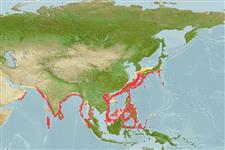Environment: milieu / climate zone / depth range / distribution range
Ecologia
marinhas demersal; intervalo de profundidade 100 - ? m (Ref. 114953). Tropical; 42°N - 0°N, 55°E - 143°E (Ref. 114953)
Indo-West Pacific; Oman (Arabian Sea) to north-east Asia (China and Japan).
Tamanho / Peso / Idade
Maturity: Lm ? range ? - ? cm
Max length : 18.0 cm TL macho/indeterminado; (Ref. 9913); common length : 20.0 cm TL macho/indeterminado; (Ref. 114953)
Found in continental waters, both inshore and offshore (Ref. 9913). Mainly feeds on crustaceans and polychaetes (Ref. 114953). Biology little known (Ref. 9913) but reported to produce 4-6 young each gestation (Ref. 114953). Adult males and females known at 15 cm TL; common size reported to reach 35 cm TL (Ref. 114953). The electric organs present on disc are used to stun the prey.
Life cycle and mating behavior
Maturities | Reprodução | Spawnings | Egg(s) | Fecundities | Larvas
Compagno, L.J.V. and P.R. Last, 1999. Narkidae. Sleeper rays. p. 1443-1446. In K.E. Carpenter and V.H. Niem (eds.) FAO identification guide for fishery purposes. The living marine resources of the Western Central Pacific. FAO, Rome. (Ref. 9913)
Categoria na Lista Vermelha da IUCN (Ref. 130435)
Utilização humana
Pescarias: pouco comercial
Ferramentas
Relatórios especiais
Descarregue XML
Fontes da internet
Estimates based on models
Preferred temperature (Ref.
123201): 19 - 28.2, mean 26.4 °C (based on 992 cells).
Phylogenetic diversity index (Ref.
82804): PD
50 = 0.6252 [Uniqueness, from 0.5 = low to 2.0 = high].
Bayesian length-weight: a=0.01000 (0.00244 - 0.04107), b=3.04 (2.81 - 3.27), in cm total length, based on all LWR estimates for this body shape (Ref.
93245).
Nível Trófico (Ref.
69278): 3.2 ±0.3 se; based on size and trophs of closest relatives
Resiliência (Ref.
120179): Baixo, tempo mínimo de duplicação da população 4,5 - 14 anos (Assuming fecundity<100).
Fishing Vulnerability (Ref.
59153): Low vulnerability (10 of 100).
